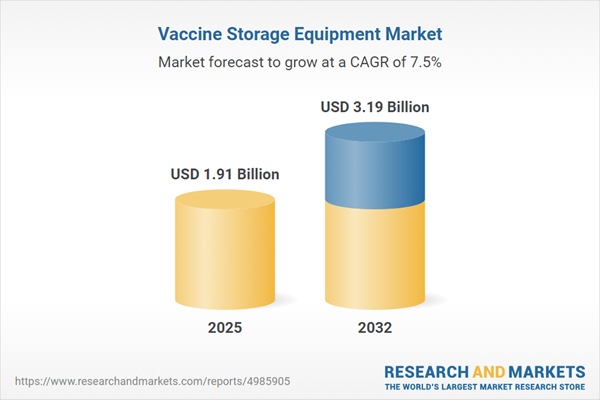Speak directly to the analyst to clarify any post sales queries you may have.
The vaccine storage equipment market plays a crucial role for organizations seeking secure, compliant, and scalable solutions that safeguard immunization efforts and bolster risk management. Reliable storage technologies support leaders as they address changing regulatory requirements and complex supply chain challenges.
Market Snapshot: Vaccine Storage Equipment Market Size and Growth Drivers
The global vaccine storage equipment market posts steady growth, propelled by expanding immunization programs and evolving regulatory landscapes. Rising investment in cold chain infrastructure, continuous compliance enhancements, and modernization projects are core drivers. Increased adoption of automated solutions, high-precision temperature technologies, and advanced monitoring systems strengthens operational continuity and risk mitigation. Sector leaders prioritize both resilient infrastructure and rapid adaptation to regulatory and logistical changes, securing the vaccine storage equipment market’s role in global public health.
Scope & Segmentation of the Vaccine Storage Equipment Market
A detailed segmentation framework in the vaccine storage equipment market enables targeted procurement, compliance, and sustainability strategies. Understanding these segments supports tailored adoption and informs region-specific deployment across public health initiatives.
- Equipment Types: Includes cold boxes, vaccine carriers, freezers, ultra-low temperature units, refrigerators, and electronic monitoring devices, covering deployment needs in central medical hubs and remote centers alike.
- Technologies: Absorption cooling, compressor-based solutions, and thermoelectric systems adapt to both fixed and mobile storage applications.
- Temperature Ranges: Ranges from standard cold storage needs to ultra-low temperature conditions, accommodating diverse vaccine requirements.
- Capacity Ranges: Options vary from compact units ideal for clinics to large-scale equipment suited for distribution hubs, allowing resource optimization.
- Power Sources: Grid-connected, battery-powered, and solar-operated models provide operational continuity and enhance access in under-resourced or off-grid environments.
- End Users: Hospitals, laboratories, blood banks, manufacturers, clinics, and vaccination centers benefit from equipment that addresses specific operational and monitoring needs.
- Applications: Designed for both permanent installations and flexible mobile deployments, ensuring performance continuity in varied and sometimes challenging locations.
- Distribution Channels: Incorporates direct supplier arrangements, offline networks, and e-commerce platforms, streamlining acquisition and supporting flexible procurement.
- Geographic Coverage: Regional nuances in infrastructure, regulatory frameworks, and adoption influence supplier approaches in the Americas, Europe, Middle East, Africa, and Asia-Pacific.
- Competitive Landscape: Providers like Arctiko A/S, Biobase Biodusty, Cardinal Health, and Eppendorf AG adjust their offerings to align with shifting requirements and evolving regulations in diverse regions.
Key Takeaways for Senior Decision-Makers
- Modern insulation and high-quality compressors support stable temperature management for stored vaccines, improving safety and reducing the likelihood of spoilage during storage or transport.
- IoT-based monitoring enables continuous oversight of storage conditions, offering transparency and supporting rapid mitigation of compliance or operational risks.
- Availability of energy-efficient and solar-reliant options supports storage continuity in off-grid or resource-limited locations, enhancing sustainability performance in line with organizational mandates.
- Modular, scalable systems allow swift adaptation to changing vaccine supply volumes or urgent needs, while maintaining inventory integrity and compliance.
- Compliance-focused, environmentally conscious equipment lengthens asset lifespan and simplifies adherence to international and local standards.
- Building relationships with multiple suppliers and leveraging various procurement pathways enhances resilience against regulatory shifts or supply interruptions, ensuring operational stability.
Tariff Impact: Navigating Supply Chain Challenges in Vaccine Storage Equipment
Recent U.S. tariffs on compressors and sensors have led manufacturers to diversify supplier networks and increase local assembly, maintaining product reliability and consistent supply. Applying for exemption status where feasible, organizations have ensured continued access to compliant storage solutions while maintaining procurement reliability. These adjustments allow healthcare providers to respond quickly to new regulatory directives and evolving market conditions.
Methodology & Data Sources
This market evaluation uses structured interviews with top manufacturers, logistics partners, and key stakeholders. Findings are verified through technical documentation and accepted global compliance standards, ensuring insights for procurement decision-makers are credible and actionable.
Why This Report Matters
- Breaks down market segmentation and regional dynamics to help executive teams manage risk and prioritize investment where it matters.
- Equips leadership with insights to leverage new technologies and adapt operations in response to emerging regulatory and supply chain complexities.
- Supports procurement and logistics leaders in implementing resilient, compliant storage strategies that meet organizational objectives and industry standards.
Conclusion
Investing in advanced vaccine storage equipment ensures organizations maintain regulatory compliance, secure vaccine quality, and support operational resilience. Adopting robust solutions prepares healthcare systems for uncertainty and evolving global conditions.
Additional Product Information:
- Purchase of this report includes 1 year online access with quarterly updates.
- This report can be updated on request. Please contact our Customer Experience team using the Ask a Question widget on our website.
Table of Contents
3. Executive Summary
4. Market Overview
7. Cumulative Impact of Artificial Intelligence 2025
Companies Mentioned
The companies profiled in this Vaccine Storage Equipment market report include:- Arctiko A/S
- Biobase Biodusty(Shandong), Co., Ltd.
- C.F. di Ciro Fiocchetti & C. s.n.c.
- Cardinal Health, Inc.
- China Beijing HiYi Technology Co., Ltd
- Dulas Ltd.
- Eppendorf AG
- Ethicheck Ltd.
- Helmer Scientific Inc.
- Labcold Limited
- PHC Holdings Corporation
- Philipp Kirsch GmbH
- Qingdao Haier Biomedical Co., Ltd.
- Rollex Group Australia PTY Ltd.
- Schenker AG
- Standex International Corporation
- Thermo Fisher Scientific Inc.
- Thermoline Scientific Equipment Pty Ltd.
- TITAN Containers S/A
- Vestfrost, A/S
- Zhongke Meiling Cryogenics Co., Ltd.
- Azenta, Inc.
Table Information
| Report Attribute | Details |
|---|---|
| No. of Pages | 199 |
| Published | November 2025 |
| Forecast Period | 2025 - 2032 |
| Estimated Market Value ( USD | $ 1.91 Billion |
| Forecasted Market Value ( USD | $ 3.19 Billion |
| Compound Annual Growth Rate | 7.5% |
| Regions Covered | Global |
| No. of Companies Mentioned | 23 |









